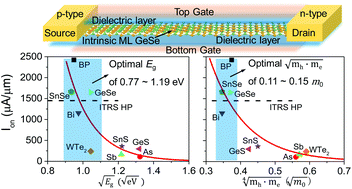Sub-10 nm tunneling field-effect transistors based on monolayer group IV mono-chalcogenides†
Abstract
The development of air-stable channels with a high on-state current (Ion) is in high demand for the feasible application of TFETs. Monolayer group IV mono-chalcogenides (i.e., GeS, GeSe, SnS, and SnSe), as emerging air-stable atomic-thin semiconductors, are potential channels for sub-10 nm tunneling field-effect transistors due to their high carrier mobility and anisotropic electronic properties. Herein, we investigated the performances of sub-10 nm monolayer (ML) group IV mono-chalcogenide TFETs using ab initio quantum transport simulation. The ML GeSe TFET exhibited the best performance with regards to both high Ion and low leakage current (Ileak) among the four devices, followed by the ML SnSe TFET with a high Ion. The Ion of the optimal ML GeSe TFET with a physical gate length of Lg = 10 nm surpasses the International Technology Roadmap for Semiconductors (ITRS, 2013 Edition) requirements for high-performance (HP) and low-power (LP) devices, simultaneously, and that of the ML SnSe TFET with Lg = 10 nm surpasses the requirement of ITRS HP devices. In combination with our former works, we suggest an Eg of 0.77–1.19 eV and  of 0.11–0.15m0 to search for competitive 2D channels with a high Ion for HP application in TFET devices with a planar homogeneous p–i–n architecture.
of 0.11–0.15m0 to search for competitive 2D channels with a high Ion for HP application in TFET devices with a planar homogeneous p–i–n architecture.



 Please wait while we load your content...
Please wait while we load your content...